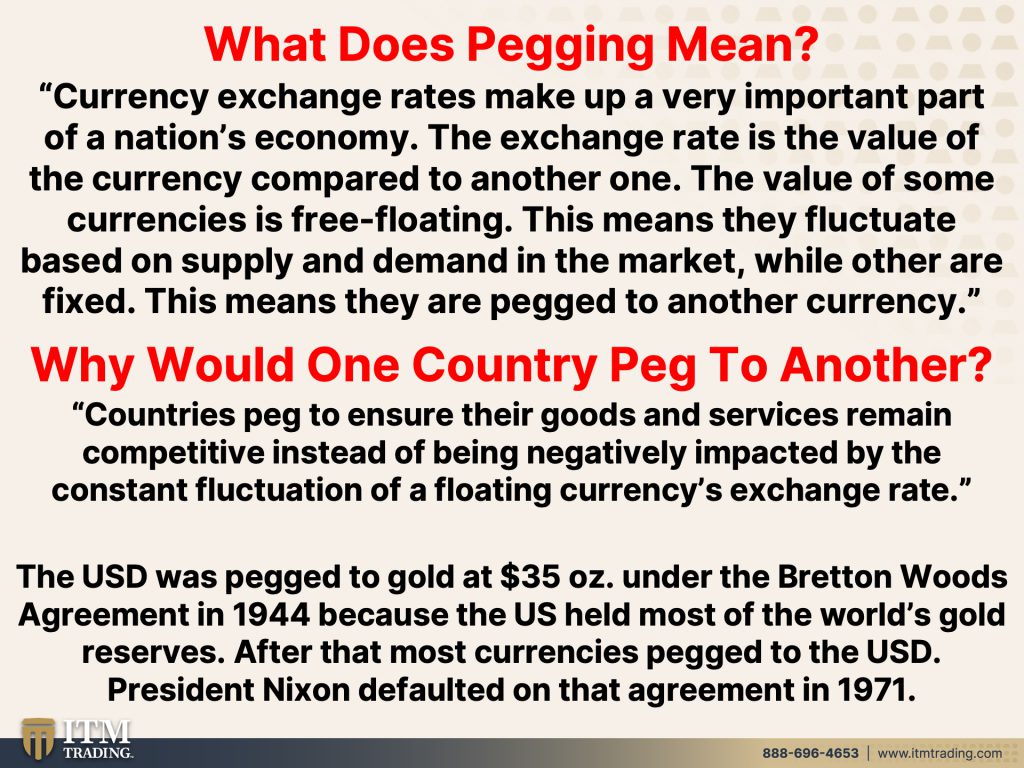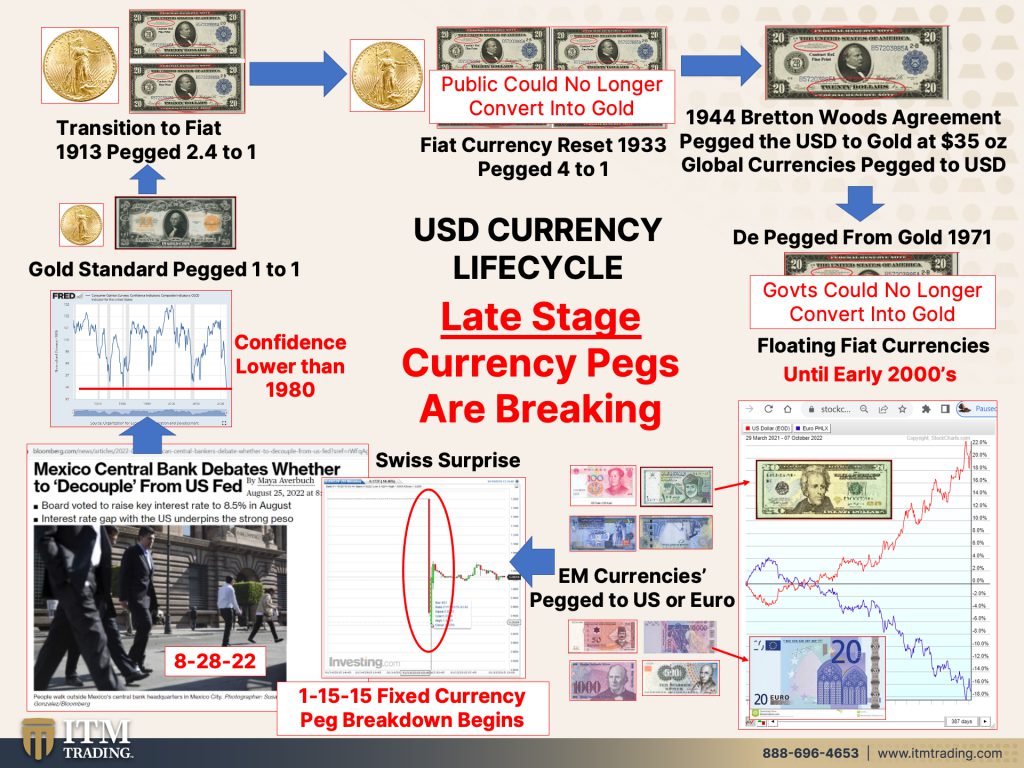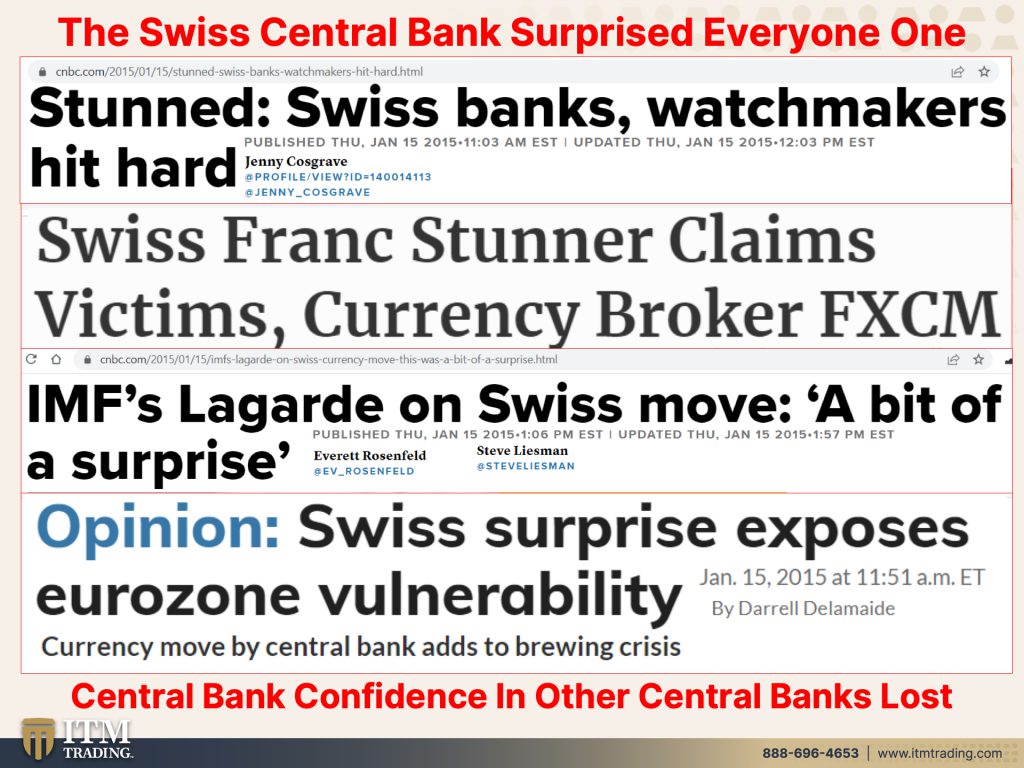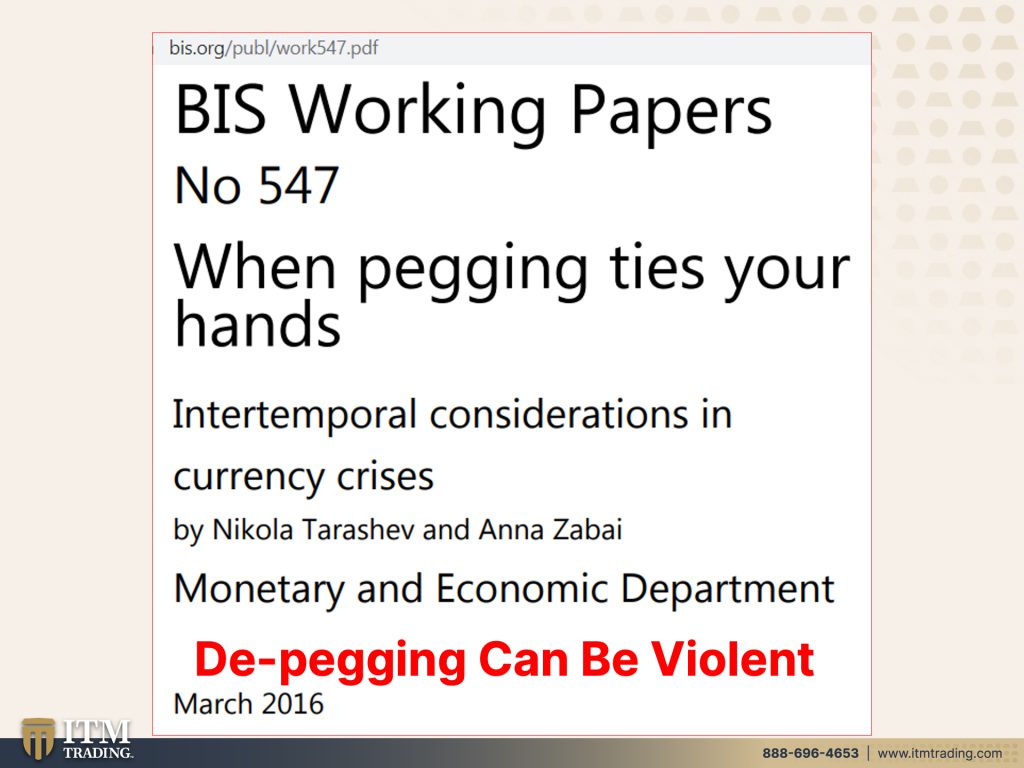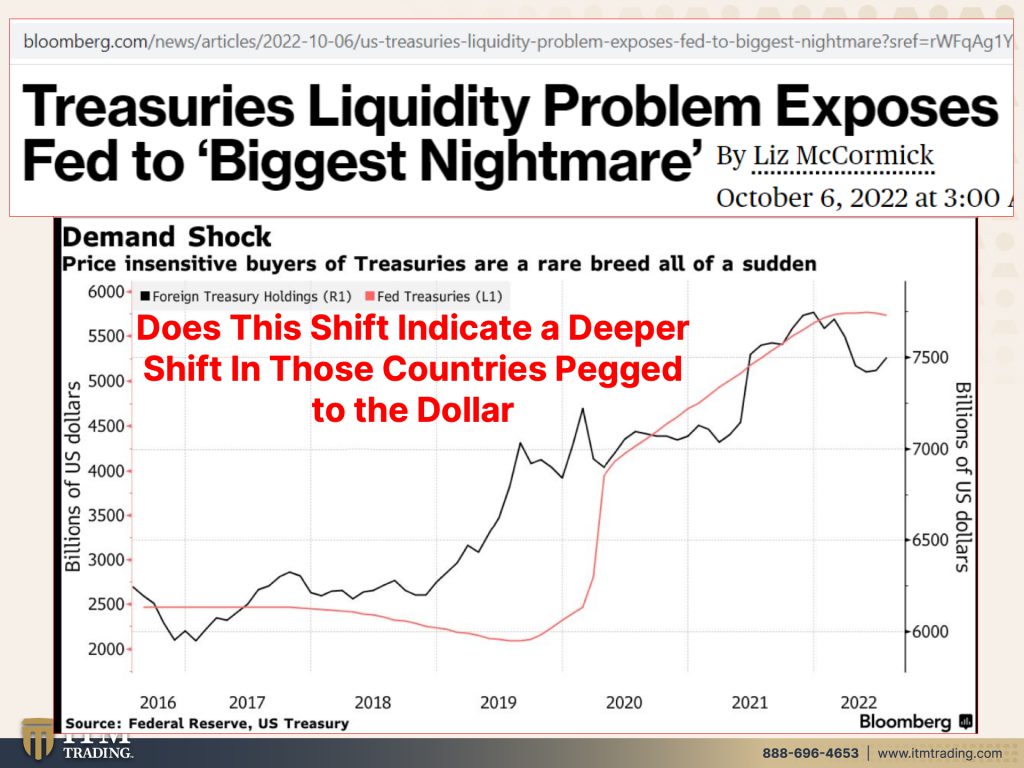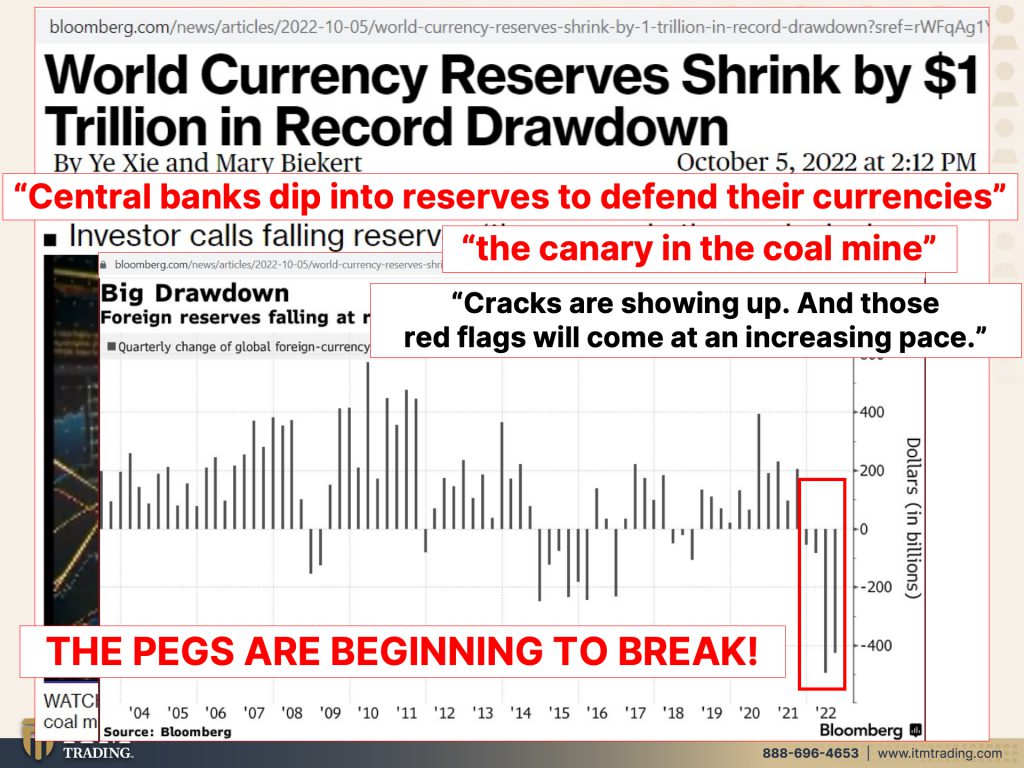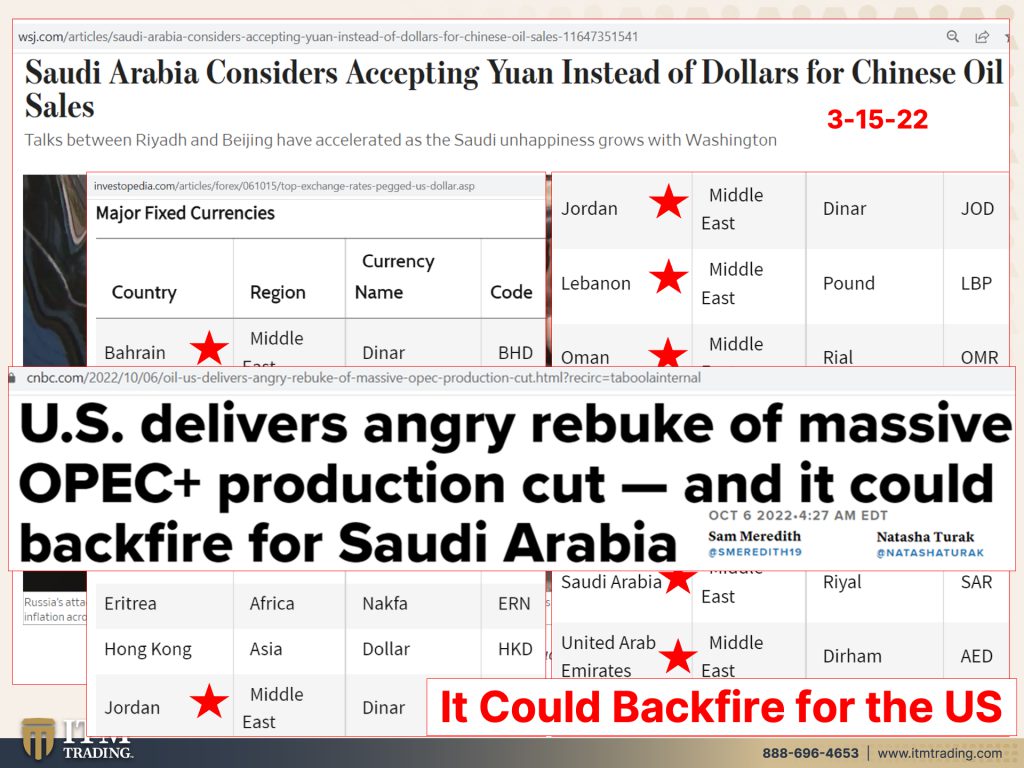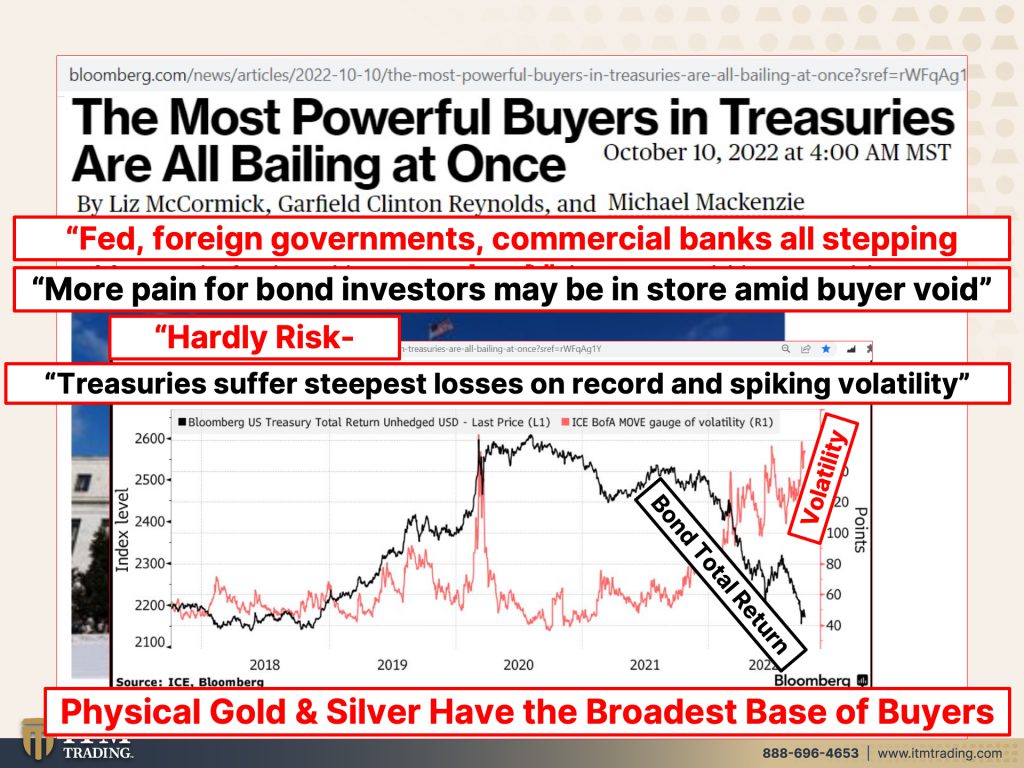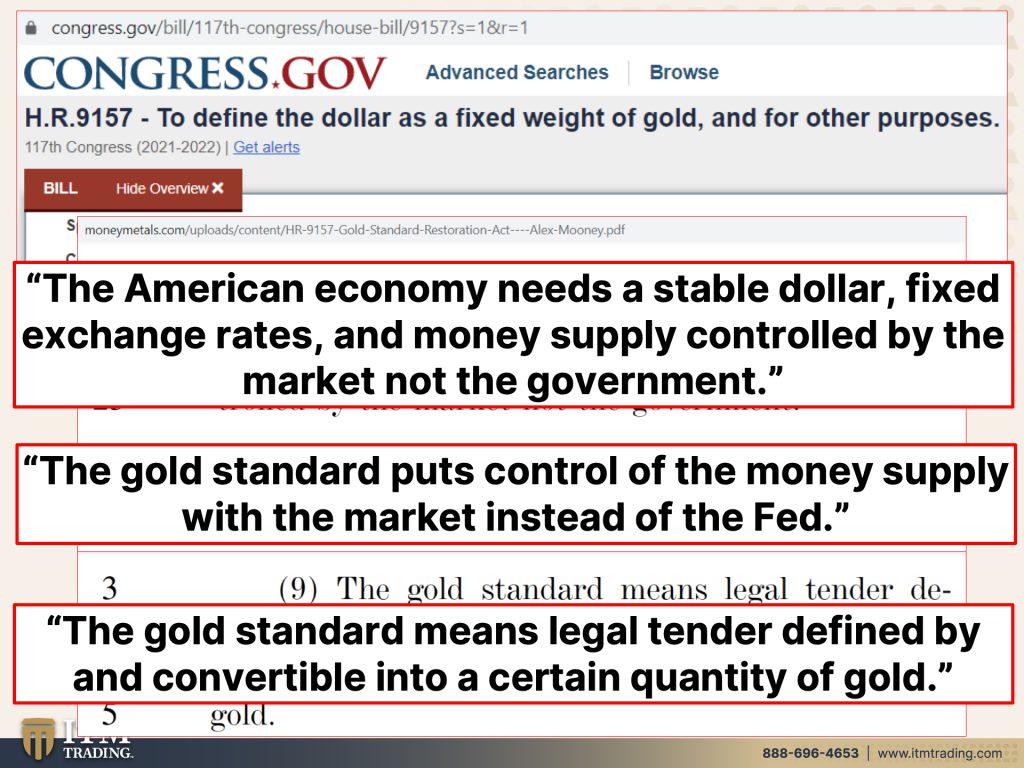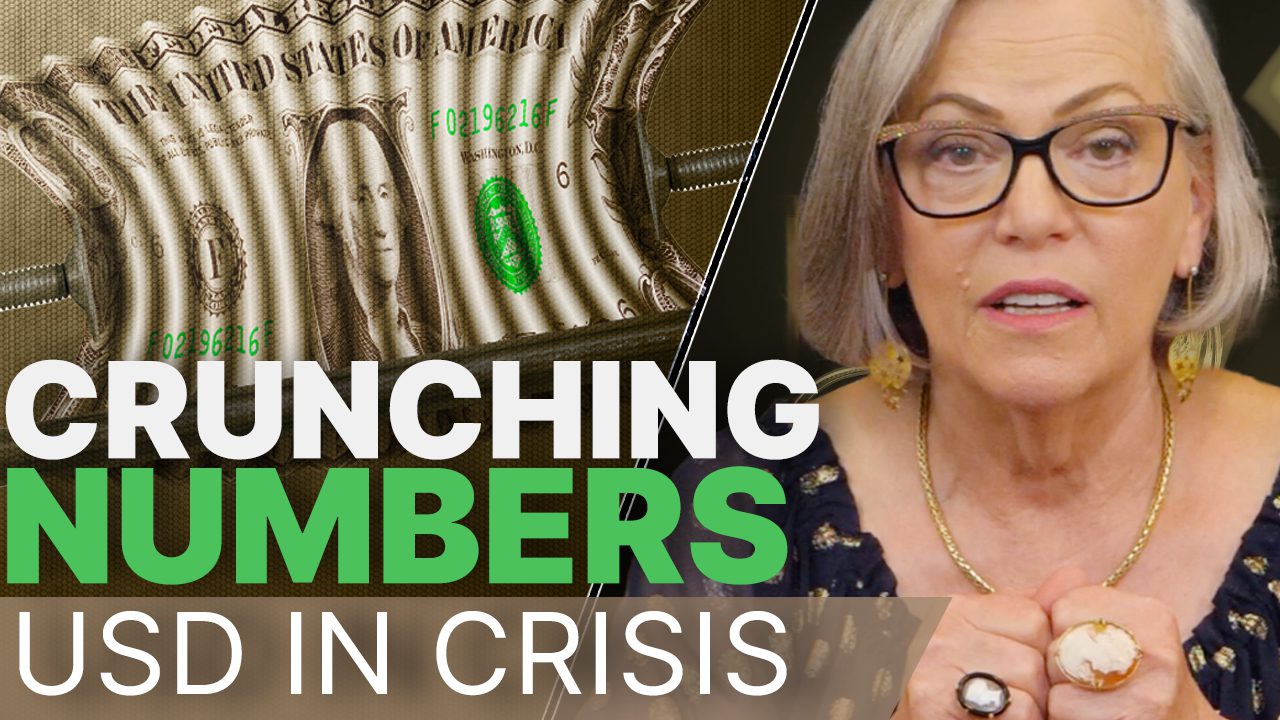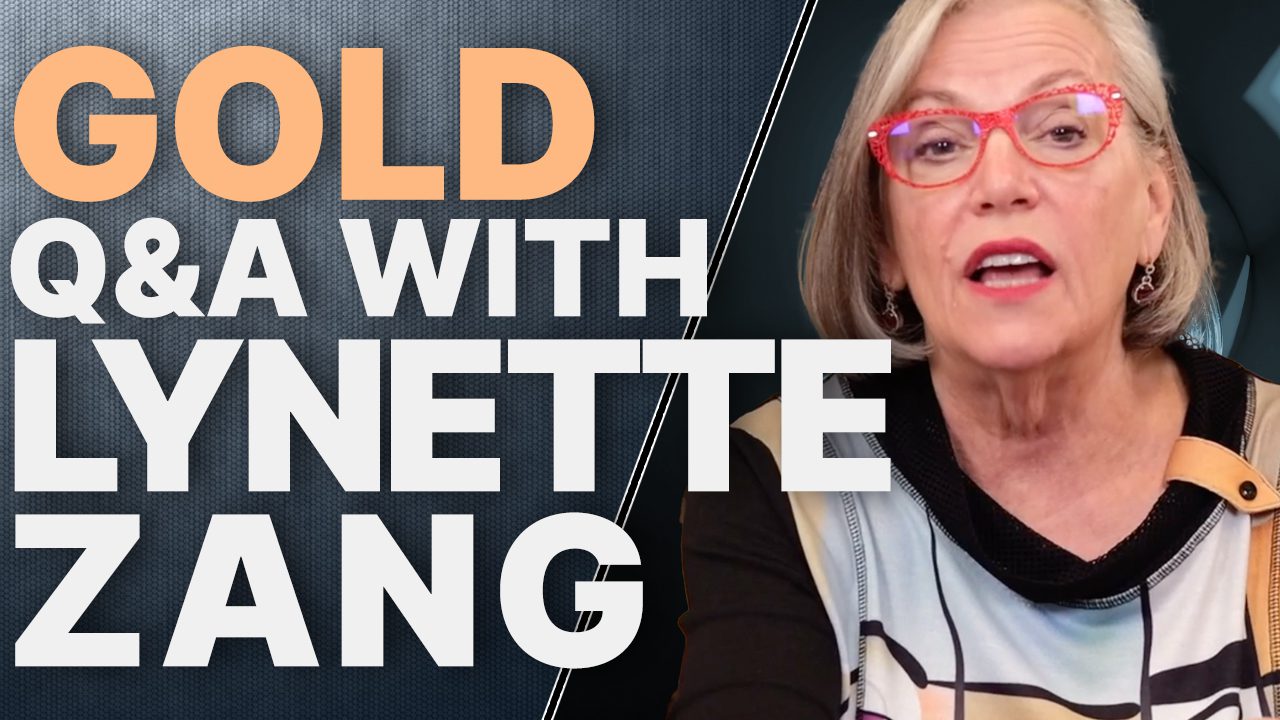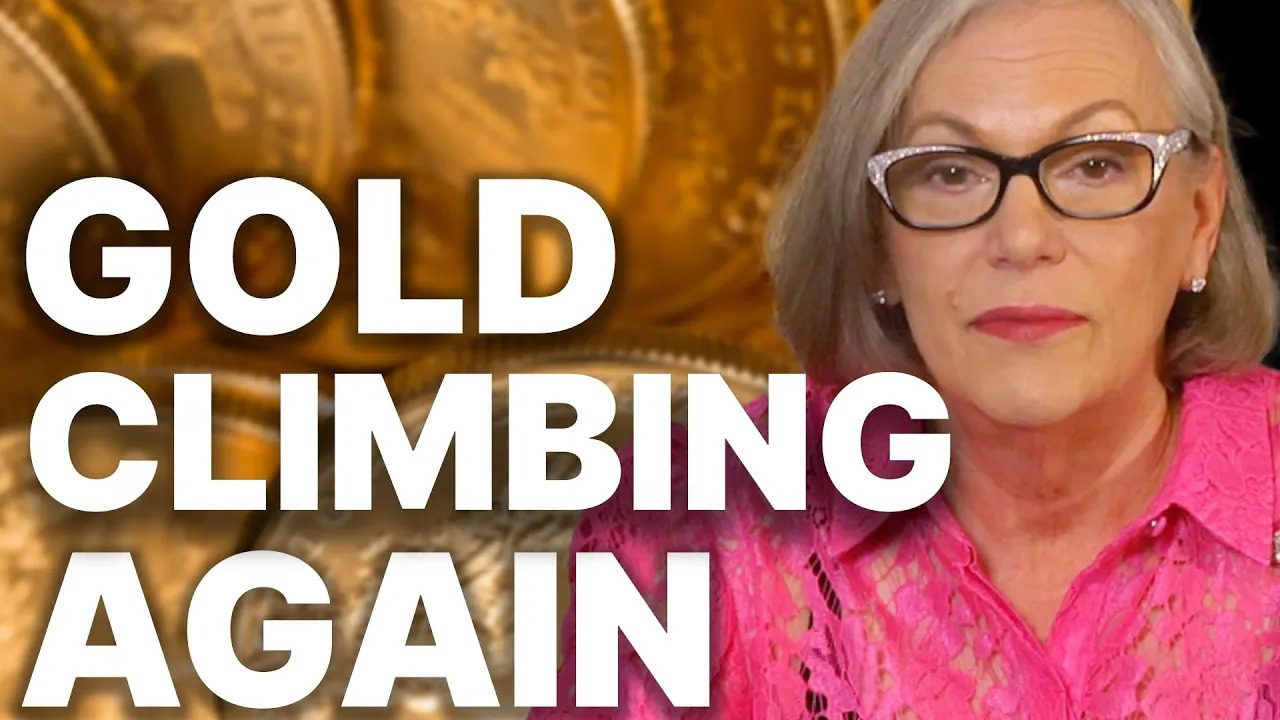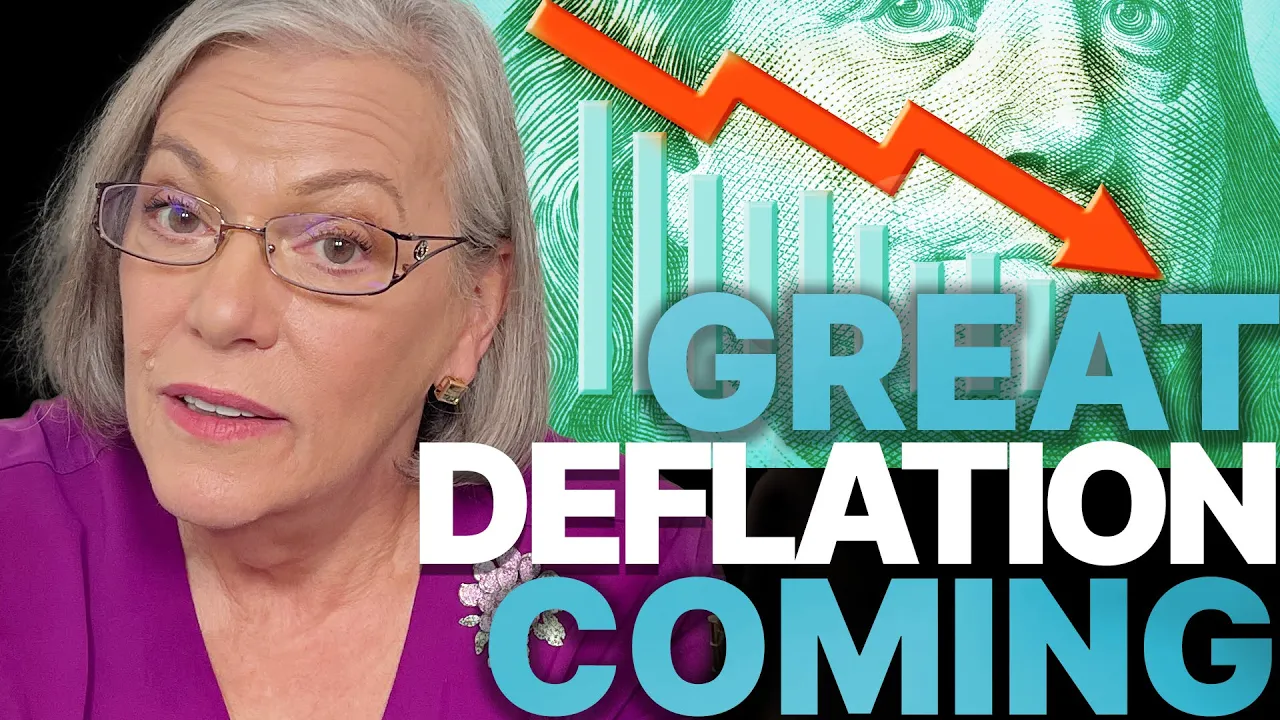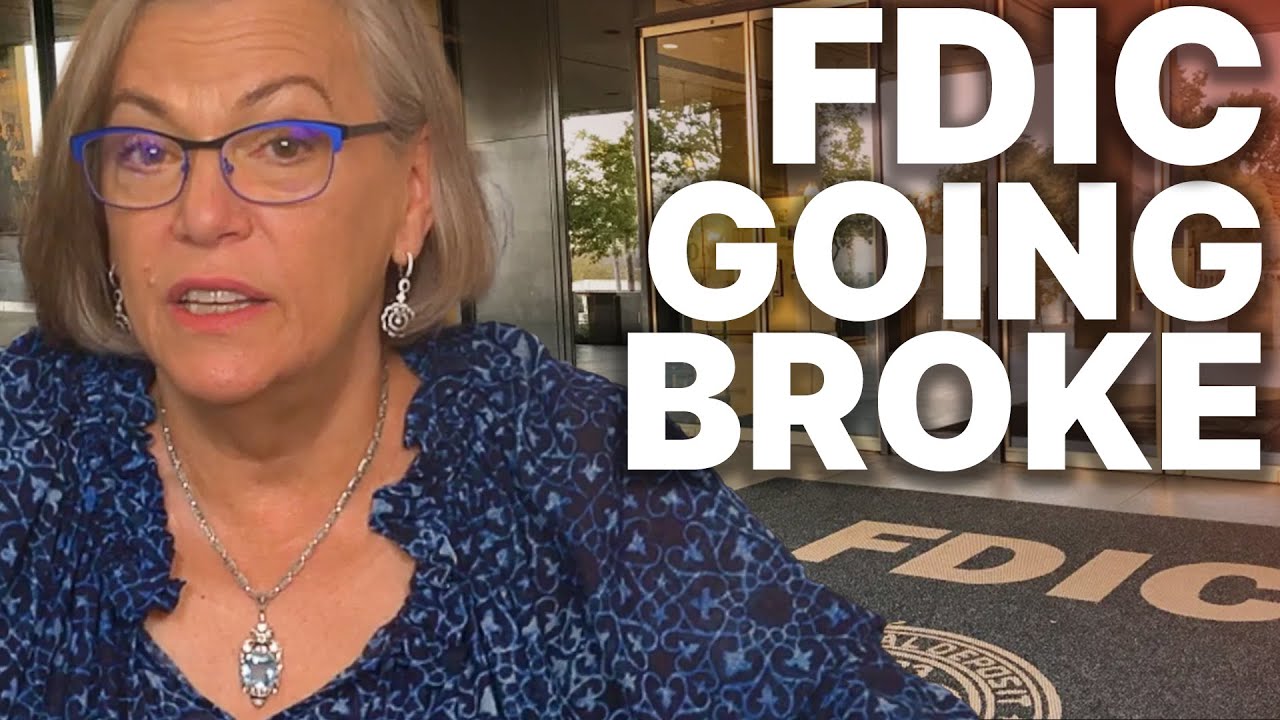Will this Peg the Dollar to Gold? Why This Matters and What This Means to You | by Lynette Zang
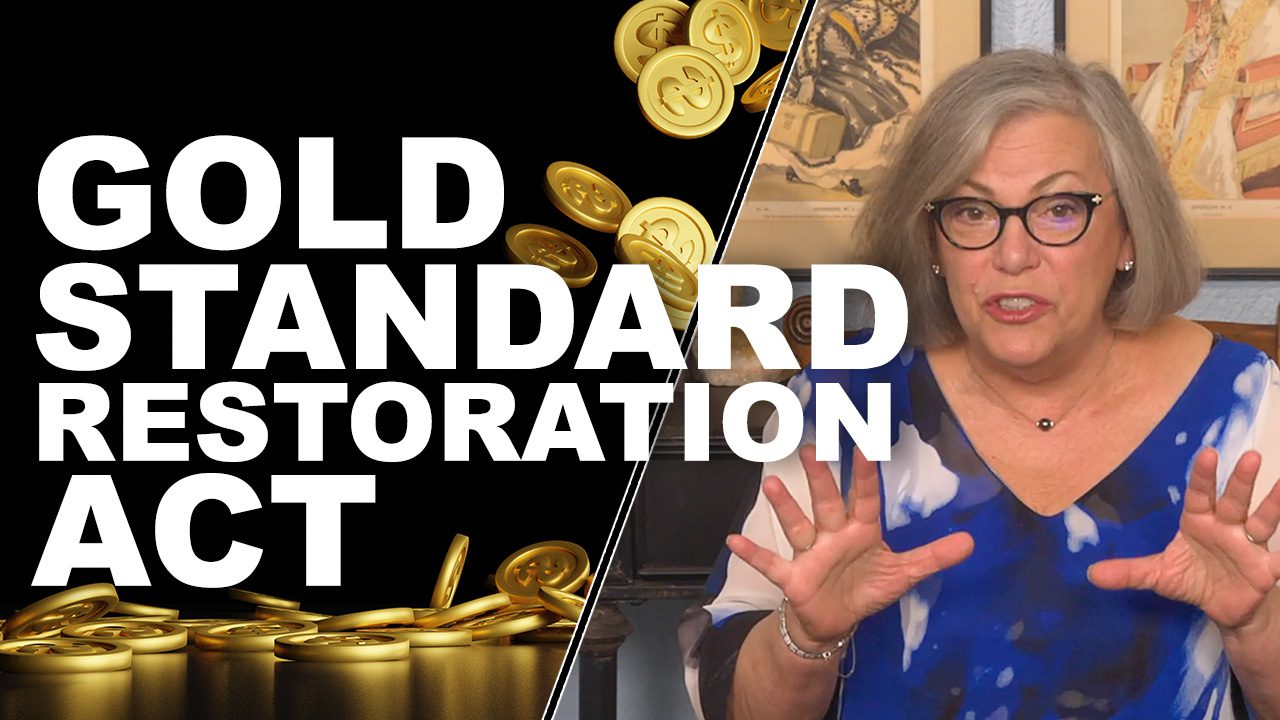
Everyone wants to feel secure, they want to know what’s going to happen day after day so they can save for the future and build a life. It should be apparent to everybody right now that things are more uncertain than they’ve ever been. The IMF and Jamie Dimon over at Chase are warning us of an imminent recession. But what happens when the Federal Reserve pivots like the Bank of England pivots? Why would they? Well, that’s what we’re going to talk about today, the de-pegging of the world, and it’s a very dangerous place.
CHAPTERS:
0:00 Crisis is Brewing
1:47 What Does Pegging Mean?
4:08 USD Currency Lifecycle
10:44 Swiss Central Bank Surprise
12:53 Treasuries Liquidity Problem
14:37 World Currency Reserves Shrink
16:43 Major Fixed Currencies
18:57 Buyers in Treasuries Bailing at Once
22:06 H.R. 9157 “Gold Standard Restoration Act”
26:31 Start Your Strategy with ITM Trading
TRANSCRIPT FROM VIDEO:
Everyone wants to feel secure, like they know what’s going to happen day after day after day, so they can save for the future, build a life. But it should be pretty apparent to everybody right now that things are more uncertain than they’ve frankly ever been with the IMF and Jamie Dimon over at Chase coming out and warning us of an imminent recession. But what happens when the Federal Reserve pivots like the Bank of England pivots, and why would they? Well, that’s what we’re gonna talk about today, the de-pegging of the world, and it’s a very dangerous place, coming up.
I’m Lynette Zang, Chief Market Analyst here at ITM Trading a full service physical, physical gold and silver dealer, specializing in custom strategies to help us get through and sustain a standard of living. And also to put us in a position to take advantage of the opportunities that present. Because make no mistake, we have entered the era of de-pegging. Now, first of all, let me define pegging and de-pegging for you so you understand what we’re going through here.
First, let’s start with pegging. And it’s pretty simple. Now, currency exchange. So one currency to the other make up a very important part of a nation’s economy. And it’s that exchange rate that countries want to be able to count on. Now, some currencies are free floating. So for example, the Euro against the dollar that happens in a larger economy, an advanced economy. This means that they fluctuate based upon supply and demand and frankly, central bank manipulation in the markets while others are fixed. And that means that their currency is directly pegged or tied to another currency, typically either the Euro or the US dollar. So why would one country peg to another country? That’s because they want to ensure that their goods and services remain competitive instead of being negatively impacted by the constant fluctuation of a floating currencies exchange rate, which means basically emerging markets peg to evolved markets, advanced economies to stabilize their currencies. Now, back in 1944, during Brenton Woods, the US agreed to peg our currency, the US dollar, to $35 ounce gold. And then the whole, pretty much the whole world’s currencies pegged to the US dollars. Now of course, when Nixon defaulted and reneged on that agreement in 1971, all of the pegs were broken and we entered a new era, a position where we were in a debt-based backing for the US currency. So from there forward, the currency was backed by the full faith and credit of the government. In other words, as long as you trust them, you’ll loan them money. So it’s the government’s ability to grow more debt.
Now, look, I talk about currency life cycles all the time because there are typical repeatable patterns around that. And so we are now entering and actually we, we started entering it in 2015, a different phase in the currency’s life. So let me just take this through to you because in the beginning, gold was pegged. It was a 20th of ounce to $1, but it was pegged on a one to one ratio. Then, when they brought in and legalized the Federal Reserve, that shifted from a 1 to 1 to a 2.4 to 1, which means that the Federal Reserve could now print $2.40 for every 20th of an ounce of gold held in deep storage. In 1933, that peg shifted again to a four to one, and of course they took away a citizen’s ability to convert dollars back into gold. Now, the reason why this is significant, and we’re gonna come back to this cause this is such an important concept for you guys to understand, is that as long as we were on a gold standard and the citizens had the right to redeem dollar bills, well it doesn’t matter what it is really dollar bills for gold, it put the power in the hands of the public because any government, if you didn’t like what they were doing, you just went into the bank with one of these and walked out with one of these, Oops, where’s that camera <laugh> with one of those. And so that created restrictions around a government, what a government could do. All right, well once the public could no longer do that, well then the world, as you know, we went into World War II, etcetera. And in Brenton Woods, like I said earlier, the world agreed to peg their currencies to the US dollar that was pegged to gold at a $35 ounce price. But of course that didn’t last very long in 1971. And actually as we went into, as the US went into the Vietnam War, those pegs were breaking because we were printing a lot more money inflating shipping out inflation to the global economies. And so those pegs broke and at that point, governments could no longer convert their dollars into gold either. Of course, there was, there was not that much gold left in the system at that point. Actually less in the US than prior to the confiscation in 33 was, was a bit of a problem. And that de-pegging where all the currencies were free floating lasted until early 2000. Now you can see that this is a relative performance chart between the US dollar and the Euro dollar. And they absolutely, or the Euro, and they absolutely mirror each other. And in the early mid two thousands, emerging currencies then pegged themselves either to the US dollar or the Euro. So that’s why today there’s such a big problem with those emerging markets that are pegged to the Euro or even pegged to the dollar either one. Cause as we keep hearing about such a strong dollar that has an impact. Cause in order to maintain the peg, you have to sell or buy reserves to maintain that peg that connection exactly where within a narrow range to either the dollar or the euro. Well, in 2015 things started to break down. Peg started to break down with the Swiss surprise where they were pegged to the Euro and they kept promising that it was the most important thing, the most important peg. They were going to remain that peg and then all of a sudden they didn’t. We’re gonna talk a little bit more about that in a little bit. And now we’re hearing recently where Mexico is thinking about de-pegging from the dollar from the US dollar. So even though it’s been a few years in between, really what the currencies, what actually the globe learned in particularly central banks is that when it comes down to it, it’s every central bank for itself. And the US has been guiding people and getting really, really ticked off. And you ask me how long this can last? It can last until confidence in the system, central banks, governments, and the currency is gone. And right now we are actually sitting at the lowest consumer confidence level, like since we started tracking it ever 1980 is was actually when it was not even as low as this. So we are getting to that point. 1980 was the kickoff of the debt based system. Seventies and eighties was the kickoff. Now we are at the end. This is not a good place to be unless you have protection, real money. That’s what has what stood the test of time. So what you really need to know is that we are in the late stage. While I can’t tell you it’s Tuesday morning at 8:35, it very well could be. The world is very fragile as we’re hearing from everybody, the IMF, the BIS, even goodness gracious, even Jamie Diamond who says we’ll be within in a recession within the next six to nine months. It’s gonna be worse than a recession. Will the Fed pivot? Because that’s all about that confidence and that credibility. We’re at the end and I really hope that you can see that.
But let me show you what a de-pegging looks like. The Swiss Central Bank surprised everyone, normal merchants, the banks, and of course a lot of businesses went out of business because they were going in one direction. And that very violent peg occurred. Even at the IMF, Christine Lagarde, who was the head of the IMF at that time, this back of 2015, 2016 rather no 15. Even she said this was a bit of a surprise, they didn’t tell anybody, but what it really did was expose the Eurozone vulnerability because this is a cluster of pegged currencies. And in reality and in history, no pegs last forever. Does Italy have the same economy as Germany? No, they do not. But they were able by pegging, they were enabled to borrow at the low rates of Germany even though they really didn’t qualify. Same thing with Greece. I mean we, we’ve known what happened with the sovereign debt crisis, etcetera. So you can see that this really jeopardizes the very existence of the Eurozone. But critically, seriously critically, what you really need to know is that central banks confidence that they can work together in a coordinated fashion and a hundred percent trust each other. It’s gone. Okay? It’s gone. No matter how they act or they behave or what they say, no, that’s what everybody learned. All central bankers for themselves.
But hey, right after that, when pegging ties your hands, now they’re saying pegging is really good even though it’s never ever, ever worked throughout history. But hey, this time is different. I don’t think so. And it can be very, very violent. So this is what you need to be prepared for. This is what’s stable because we know the problem in the treasury market. In fact, this is the bedrock of the global economy. So all those currencies that are either free floating or pegged, this is what underpins everything. And we’ve been talking about the liquidity problem for years. It hasn’t gotten better, even with all the money printing that hasn’t gotten better. It’s actually only gotten worse. And you know what their biggest nightmare is? What happened to the Bank of England when they had to pivot? Here they are tightening policy, raising rates and trying to sell off. You can, Oops, I forgot to grab my little pointer. Trying to sell off their massive balance sheet. And what if they have to turn around and start buying treasuries to try and support that market? And by the way, you know, the Bank of England’s efforts were very, very short lived. So does this shift indicate a deeper shift into those countries pegged to the dollar? Cause I’m telling you right now that peg is breaking.
We know that because the world reserves shrink by a trillion in record draw down to attempt to defend and maintain those pegs. So what happens when they go out of reserves? You know, the US I mean advanced economies can print more money, right? But emerging markets, they have a little bit of a challenge with that. So central banks dip into reserves to defend their currencies or really to defend that peg? That’s a big huge problem. It is a canary in the coal mine. Look at this. Draw down the biggest since they started tracking it in 2003 by a mile. Can you see how this is at the end? That’s what this is telling you. That’s what this is indicating. That’s why you can’t procrastinate. That’s a choice and it puts you in jeopardy because the whole system is breaking down and the foundation or the treasuries and the pegs. Cracks are showing up and those red flags will come at an increasing pace, which they are. I can hardly keep up with everything that’s happening. So you need to understand that when they can no longer support these pegs, they have to make that choice to break them. Okay? If it’s just one place at a time, well, you know, it’s violent and there are companies that will no longer exist and there will pe. There are people that will feel a lot of pain, but we can probably as a whole in the whole world probably deal with that. But what happens if a lot of pegs break at once? That’ll topple the system. No doubt. I mean seriously. No doubt.
What about Saudi Arabia? Hmm? They’re considering accepting yuan instead of dollars for Chinese oil? Isn’t that interesting? Considering the fact that what enabled the US to retain its position as the world reserve currency that forced the whole world to buy oil with dollars. That’s shifting big time. Now, here are some of the major currencies that are pegged fixed to the US dollar and where the stars are. These are oil producing countries in the Middle East and of course Russia is the plus in the OPEC plus. I don’t know, what do you think? What if all of those countries that said they would only accept dollars for oil and that’s why they to the dollar because then they could guarantee their income and the stability of their currency. What if they all de-pegged at the same time?
Can you wrap your brain around that? Because why would anybody want to count on the US dollar as the world reserve currency? They didn’t have to use it. Now this hyperinflation that’s coming is gonna be like, it’s gonna be horrendous all over the world, but it’s likely to be the worst in the US because we’ve had such an advantage for so long and we’re losing that. But in our arrogance, <laugh> seriously! US delivers angry re butte of massive OPEC plus production cut and it could backfire for Saudi Arabia. Guess what? It could backfire for the US as well.
Because what we’re also seeing here, is that the powerful buyers and treasuries that really don’t care about where interest rates are, they’re just there to support that market. They’re bailing all at once. This is not a good thing. Treasuries we’re taught are risk free,this is hardly risk free. It’s that bridge that’s blowing in a hurricane, back and forth, back and forth, back and forth. At what point is it going to implode? I can’t exactly tell you that moment, but I could tell you it’s going back and forth, back and forth, back and forth is not a good thing. Fed foreign governments. I’m gonna take the Fed. It’s a quote so I gotta leave it in there. But you know, do I think that the Fed is really going to be selling off or liquidating their treasuries into this? No, I mean they’ve said they’re going to and they’re fighting for their credibility. So they’ve done a little teeny weeny bit of it. But if the foreign government’s, commercial banks and the entities that they could always count on to suck up any extra bonds are pulling back. Can the fed also pull back? I don’t think so. And there are more pain for bond investors amid this buyer void. Hmm? A buyer void. Because all of these fiat money products only work in one arena, the financial arena. So you have one group of buyers, maybe multiple groups inside of that one group, like fed, foreign governments, commercial banks that typically buy these treasuries. Hmm? There’s a void. There’s really only used. This stuff is only used in one area. One, not good, not risk free. Treasuries suffer steepest losses on record and spiking volatility. Ya think? Is that going away? No, because they’re not liquid anymore. They’re not liquid. You cannot buy them and sell them easily without moving the price. This is danger, you know, warning. But physical gold and silver have the broadest base of buyer because it’s used inside of every single area of the global economy. Both of them gold and silver. Broadest base of buyer. What do you wanna go into a fight with? One little pocket knife or an arsenal? That’s what we’re talking about here. That’s exactly what we’re talking about.
Are they repositioning to back the dollar with gold? Now look, do not get me wrong. This was just introduced and I think that it’s fabulous and it certainly lays out all of the reasons why they should do it, but they cannot do it until that mountain of debt is burned off in a hyperinflationary depression. It could be a hyper deflation, doesn’t matter. They’re really the same thing. Just the flip side. There’s only one way to fight inflation that’s with deflation and there’s only one way to fight deflation, and that’s with inflation. So it makes it pretty simple. But what history also tells us, is that when all confidence is lost in the currency, then what do they do? They put a component of gold back in that currency to get the public to trust it and use it once again. A hundred percent of the time, over 4,800 times. This is exactly what’s happened. Now, the CBDC, the digital dollar they’re coming out with, that’s not gonna be the end. They’re gonna tell you, but look, if we have this digital dollar, there will be no more inflation. That’s how they’re selling it to us. It’s garbage. No more inflation, but totally deflation as they rob you of your wealth as you cannot even count. I mean these guys are changing the four functions of money down to two as a tool of barter and a measure. But you are not going to be able to guarantee any kind of wealth preservation with it because they are gonna take it away from you, period. That’s what they’re saying. That’s not me saying it. Read their stuff, I do. I try and show that to you here. But I think that this is a great step and I do think that this is probably a way to get this through Congress before we need it. Because we go into this next recession, when the Fed pivots, it’s gonna make what they did in 2020 look like chump change and the hyperinflation let it begin. I mean, I hate to say it, but it’s true because the economy, American economy needs a stable dollar, fixed exchange rates and money supply controlled by the market, not the government. Guess what? Didn’t we talk about that in the beginning? You don’t like what the government’s doing, you pull the gold out of the system and it creates restrictions around what the government can do and the central bank. Yeah, I’m all for it. The gold standard puts control of the money supply with the market instead of the Fed. And we vote with our purses. That’s true when this comes back, but that’s true right now, if you buy stocks or bonds or ETFs or annuities or you stay in cash or you buy cryptocurrencies, that’s a vote of confidence in the system, current and new for me. I’ll do that after this mess when I can see who can survive right now. Give me tried and true. 6,000 years of history. Yeah, I want the broadest base of buyer going into this knife fight. And frankly, I think everybody should. The gold standard means legal tender is defined by a convertible into a certain quantity of gold. So it doesn’t have to be a hundred percent, but it has to be some measure that can give the public enough confidence and can stabilize that currency so that you actually get fairly paid for your labor, which is what they wanna take away from you next. They’ve already got your all your purchasing power. Now they gotta go for the principle.
Going into this fight. Gold, silver, gold, silver, physically in your possession. Please do yourself a favor, do your family a favor, get it done today. If you have not already, please subscribe. So I can keep bringing you this really important information that you need to understand in order to make educated choices.
So just push that button below or go ahead and then also hit that bell. We’ll let you know when we’re going live. But remember too that we have a podcast. So you can listen to us anywhere, anytime on all major podcast platforms. And if you have not done so yet, please do yourself a favor. Call that calendly link below. Set up a time to meet with one of our precious metals consultants. They can help you develop your own customized personal strategy. The foundation, of course is gold and silver, but you also need Food, Water, Energy, Security, Barterability, as well as Wealth Preservation, Community and Shelter. And that’s the kind of thing that we talk about Beyond Gold and Silver where we’re trying to meet you. Wherever you are, you have no experience, great. There’s stuff in there for you. You’re highly experienced. Not only is there stuff in there for you, but we’re gonna ask you to help us, help other people help themselves. So if you haven’t already, please give us a thumbs up, make sure you subscribe and share, share, share, share, share. And until next we meet. Please be safe out there. Bye-bye.
SOURCES:
https://www.investopedia.com/articles/forex/061015/top-exchange-rates-pegged-us-dollar.asp
https://www.marketwatch.com/story/swiss-surprise-exposes-eurozone-vulnerability-2015-01-15
https://www.cnbc.com/2015/01/15/stunned-swiss-banks-watchmakers-hit-hard.html
https://www.investopedia.com/articles/forex/061015/top-exchange-rates-pegged-us-dollar.asp
https://www.bis.org/publ/work547.pdf
https://www.federalreserve.gov/monetarypolicy/bst_recenttrends.htm
https://fred.stlouisfed.org/series/M2V
https://www.congress.gov/bill/117th-congress/house-bill/9157?s=1&r=1
https://www.moneymetals.com/uploads/content/HR-9157-Gold-Standard-Restoration-Act—-Alex-Mooney.pdf
